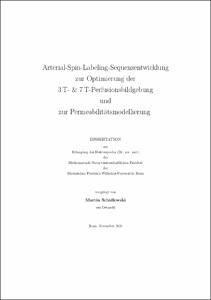Schidlowski, Martin: Arterial-Spin-Labeling-Sequenzentwicklung zur Optimierung der 3T- & 7T-Perfusionsbildgebung und zur Permeabilitätsmodellierung. - Bonn, 2022. - Dissertation, Rheinische Friedrich-Wilhelms-Universität Bonn.
Online-Ausgabe in bonndoc: https://nbn-resolving.org/urn:nbn:de:hbz:5-66177
Online-Ausgabe in bonndoc: https://nbn-resolving.org/urn:nbn:de:hbz:5-66177
@phdthesis{handle:20.500.11811/9721,
urn: https://nbn-resolving.org/urn:nbn:de:hbz:5-66177,
author = {{Martin Schidlowski}},
title = {Arterial-Spin-Labeling-Sequenzentwicklung zur Optimierung der 3T- & 7T-Perfusionsbildgebung und zur Permeabilitätsmodellierung},
school = {Rheinische Friedrich-Wilhelms-Universität Bonn},
year = 2022,
month = apr,
note = {Arterial spin labeling sequence development for optimization of 3T & 7T perfusion imaging and for permeability modeling
Pseudo-continuous arterial spin labeling (pCASL) is a magnetic resonance technique for imaging and quantifying cerebral blood flow. Magnetically labeled arterial blood serves as an endogenous tracer. Special extensions of the fundamental method fascilitate a modeling of additional physiological parameters besides cerebral perfusion. Good quantifiability and non-invasiveness make pCASL of interest for clinical use and for scientific research, which is enhanced by a wide availability and technical development of magnetic resonance scanners. The first 7 Tesla ultra-high field scanner has been approved for clinical use in 2017. Stronger magnetic fields provide the advantages of a higher signal-to-noise ratio (SNR) and a longer persisting pCASL signal. However, magnetic field inhomogeneities and energy limitations make an application more difficult.
This thesis contributes to pCASL-based perfusion measurements and a modeling of blood-brain barrier permeabilities at 3 Tesla and it addresses the challenges to further develop pCASL imaging at 7 Tesla.
The first part focuses on the development and application of pCASL for the quantitative measurement of cerebral blood flow at 3 Tesla. An efficient pCASL encoding method using Hadamard matrices is implemented and its theoretical advantages are experimentally demonstrated. Application-optimized protocols and a data processing pipeline are obtained. In vivo measurements confirm a solid data quality. The applicability for clinical measurements is demonstrated in a single case. A test-retest measurement series reveals the suitability for longitudinal and multicenter studies.
The second part considers the T2 relaxation of the pCASL signal at 3 Tesla. It focuses on a T2-based investigation of the tracer transition from the intravascular to the extravascular compartment and a potential inference on the blood-brain barrier integrity. Therefore, a sequence module is implemented for the acquisition of T2-weighted data and a study protocol implemented. Additionally, the reliability of quantitative T2 times is validated within a test-retest study. Then, a modeling approach is developed to compartmentalize the pCASL tracer into intra- and extravascularly localized fractions based on the T2 times. Additional supplementing measurements and highly simplified model assumptions stabilize the compartmentalization model, as demonstrated in vivo. As a result, pCASL-T2 times may be a relevant parameter for the investigation of physiological processes.
The third part addresses the implementation of pCASL measurements at 7 Tesla. Parallel pulse transmission techniques adapt the magnetic labeling pulses to compensate for non-ideal magnetic field distributions. Multiple adjustment concepts are implemented in a 7 Tesla pCASL sequence. Simulations and first in vivo investigations, using some of these methods, demonstrate a feasibility also at ultra-high field and an improvement of the pCASL signal compared to non-adjusting approaches.},
url = {https://hdl.handle.net/20.500.11811/9721}
}
urn: https://nbn-resolving.org/urn:nbn:de:hbz:5-66177,
author = {{Martin Schidlowski}},
title = {Arterial-Spin-Labeling-Sequenzentwicklung zur Optimierung der 3T- & 7T-Perfusionsbildgebung und zur Permeabilitätsmodellierung},
school = {Rheinische Friedrich-Wilhelms-Universität Bonn},
year = 2022,
month = apr,
note = {Arterial spin labeling sequence development for optimization of 3T & 7T perfusion imaging and for permeability modeling
Pseudo-continuous arterial spin labeling (pCASL) is a magnetic resonance technique for imaging and quantifying cerebral blood flow. Magnetically labeled arterial blood serves as an endogenous tracer. Special extensions of the fundamental method fascilitate a modeling of additional physiological parameters besides cerebral perfusion. Good quantifiability and non-invasiveness make pCASL of interest for clinical use and for scientific research, which is enhanced by a wide availability and technical development of magnetic resonance scanners. The first 7 Tesla ultra-high field scanner has been approved for clinical use in 2017. Stronger magnetic fields provide the advantages of a higher signal-to-noise ratio (SNR) and a longer persisting pCASL signal. However, magnetic field inhomogeneities and energy limitations make an application more difficult.
This thesis contributes to pCASL-based perfusion measurements and a modeling of blood-brain barrier permeabilities at 3 Tesla and it addresses the challenges to further develop pCASL imaging at 7 Tesla.
The first part focuses on the development and application of pCASL for the quantitative measurement of cerebral blood flow at 3 Tesla. An efficient pCASL encoding method using Hadamard matrices is implemented and its theoretical advantages are experimentally demonstrated. Application-optimized protocols and a data processing pipeline are obtained. In vivo measurements confirm a solid data quality. The applicability for clinical measurements is demonstrated in a single case. A test-retest measurement series reveals the suitability for longitudinal and multicenter studies.
The second part considers the T2 relaxation of the pCASL signal at 3 Tesla. It focuses on a T2-based investigation of the tracer transition from the intravascular to the extravascular compartment and a potential inference on the blood-brain barrier integrity. Therefore, a sequence module is implemented for the acquisition of T2-weighted data and a study protocol implemented. Additionally, the reliability of quantitative T2 times is validated within a test-retest study. Then, a modeling approach is developed to compartmentalize the pCASL tracer into intra- and extravascularly localized fractions based on the T2 times. Additional supplementing measurements and highly simplified model assumptions stabilize the compartmentalization model, as demonstrated in vivo. As a result, pCASL-T2 times may be a relevant parameter for the investigation of physiological processes.
The third part addresses the implementation of pCASL measurements at 7 Tesla. Parallel pulse transmission techniques adapt the magnetic labeling pulses to compensate for non-ideal magnetic field distributions. Multiple adjustment concepts are implemented in a 7 Tesla pCASL sequence. Simulations and first in vivo investigations, using some of these methods, demonstrate a feasibility also at ultra-high field and an improvement of the pCASL signal compared to non-adjusting approaches.},
url = {https://hdl.handle.net/20.500.11811/9721}
}






